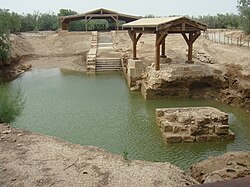Jordan River
The Jordan River (Hebrew: נהר הירדן nehar hayarden, Arabic: نهر الأردن nahr al-urdun) is a river in Southwest Asia that flows through the Great Rift Valley into the Dead Sea. Many people think it is one of the world's most sacred rivers.
| Jordan River | |
|---|---|
| Mouth | Dead Sea |
| Length | 251 km (156 mi) |
| Mouth elevation | −416 m (−1,365 ft) |
It is 251 kilometres (156 mi) long. Its tributaries are:
- The Hasbani (Hebrew: שנירsenir, Arabic: الحاصباني hasbani), which flows from Lebanon.
- The Banias (Hebrew: חרמון hermon, Arabic: بانياس banias), that comes from a spring at Banias at the foot of Mount Hermon.
- The Dan (Hebrew: דן dan, Arabic: اللدان leddan) with its source at the foot of Mount Hermon.
- The Ayoun (Hebrew: עיון ayoun, Arabic: عيون ayoun), which flows from Lebanon.
The four rivers join to form the Jordan in northern Palestine, near kibbutz Sede Nehemya. The Jordan drops quickly in a 75 kilometer run to Lake Hula, which is a little below sea level in the Galilee sea. Then it drops much more in about 25 kilometers to the Sea of Galilee. The last section has less gradient, and the river begins to twist before it enters the Dead Sea, which is about 400 meters below sea level and has no outlet. Two major tributaries enter this last section from the east: the Yarmouk River and Jabbok River.
In 1964, Israel began operating a dam that takes water from the Sea of Galilee, a major Jordan River water provider, to the national water carrier. Also in 1964 Jordan built a channel that takes water from the Yarmouk River, a main tributary of the Jordan River. This caused great damage to the ecosystem. Syria has also built reservoirs that catch the Yarmouk's waters.
In modern times, 70% to 90% of the waters is used for human purposes and the flow is much smaller. Because of this, and the high evaporation rate of the Dead Sea, the sea is shrinking. All the shallow waters of the southern end of the sea have been drained in modern times, and are now salt flats.
The water from the Jordan is a very important resource to the dry lands of the area. It is a source of conflict between Lebanon, Syria, Jordan, and Palestine.
In the Bible
In the Hebrew Bible, the Jordan is referred to as the source of fertility to a large plain ("Kikkar ha-Yarden"), called "the garden of God" (Genesis 13:10). There is no regular description of the Jordan in the Bible. The New Testament states that John the Baptist baptized Jesus in the Jordan (Matt. 3:13).
Symbolic importance
The Jordan is a frequent symbol in folk, gospel, and spiritual music, or in poetic or literary works.
Because the Israelites made a difficult journey from slavery in Egypt to freedom in The Promised Land, the Jordan can be a symbol of freedom. The actual crossing is the final step of the journey, which is then complete. Also, the Jordan can mean death itself, with the crossing from life into Paradise or Heaven.
Jordan River Media
Coloured postcard of the Jordan River, by Karimeh Abbud, circa 1925
River Jordan draining into the Dead Sea
Christian women on pilgrimage to Al-Maghtas (1913)
Al-Maghtas ruins on the Jordanian side of the Jordan River are the putative location for the Baptism of Jesus and the ministry of John the Baptist
References
Other websites
| Wikimedia Commons has media related to Lua error in Module:Commons_link at line 62: attempt to index field 'wikibase' (a nil value).. |






